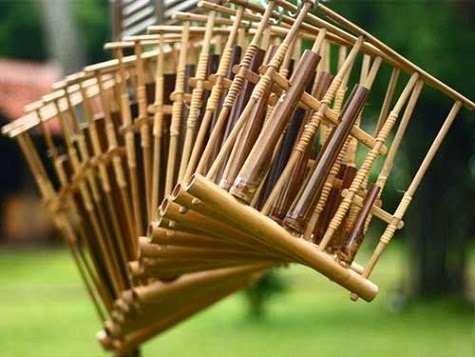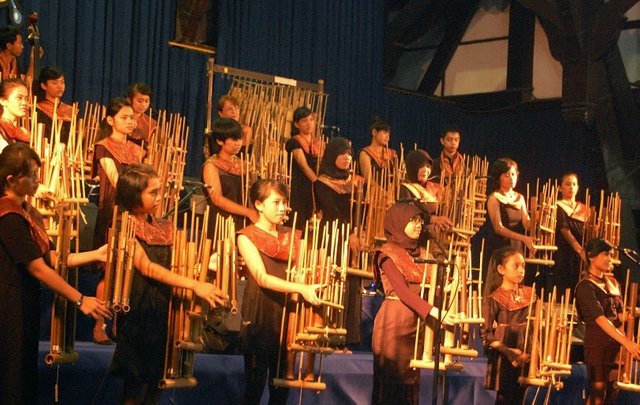Angklung
Explanation of traditional musical instruments Angklung derived from the Sundanese community of West Java. Angklung is a musical instrument multitonal (pitched double) made of bamboo. How to play it quite easily just by shaking it. The resulting sound is caused by a bamboo pipe body clash. The resulting sounds vibrate in a tone of 2, 3, to 4 tones in each size, both large and small.
Jonathan Rigg's Dictionary of the Sunda Language, published in 1862 in Batavia, writes that Angklung is a musical instrument made of bamboo pipes, cut into the edges, resembling pipes in an organ, and tied together in a frame, vibrated to produce sound. Angklung is listed as Masterpiece of Oral and Non-Angelic Cultural Heritage of UNESCO since November 2010


Origin
No clue has been found since when angklung was used, but it is suspected that its primitive form has been used in Neolithic culture that developed in the archipelago until the beginning of modern calendar, so that angklung is part of pre-Hinduism relics in Nusantara culture.
Notes on the new angklung appear referring to the time of the Sunda Kingdom (12th century to 16th century). The origin of the creation of bamboo music, such as angklung based on the view of life of the agrarian Sundanese with the source of life from rice (pare) as a staple food. This gave birth to the myth of belief in Nyai Sri Pohaci as the symbol of the life-giving Goddess of Rice (inhalation).
Baduy tribe, which is a native Sundanese society, uses Angklung as part of the ritual of initiating rice planting.
material
Bamboo which is used as angklung material is black bamboo (awi wulung) and white bamboo (awi temen). Each tone produced comes from the bamboo tube-shaped blade of each bamboo segment from small to large.
Function
The period of the Sunda kingdom, Angklung used among them as an encouragement in the battle. The function of Angklung as a pumping spirit of the people still continues to be felt until the colonial period, that is why the Dutch East Indies government had banned the community using angklung, the ban had made the popularity of Angklung decline and only played by the children at that time.
Furthermore, the songs offerings against the Goddess Sri is accompanied by a companion of the sound of percussion made from bamboo stems are packaged simple which later was born structure of bamboo musical instrument that we know now called angklung. Similarly, at the time of harvest festival and seren taun dedicated angklung game. Especially in the presentation of Angklung associated with the rice ceremony, this art becomes a show that the nature of the procession or helaran, even in some places into a convoy of Rengkong and Dongdang and Jampana (stretch of food) and so on